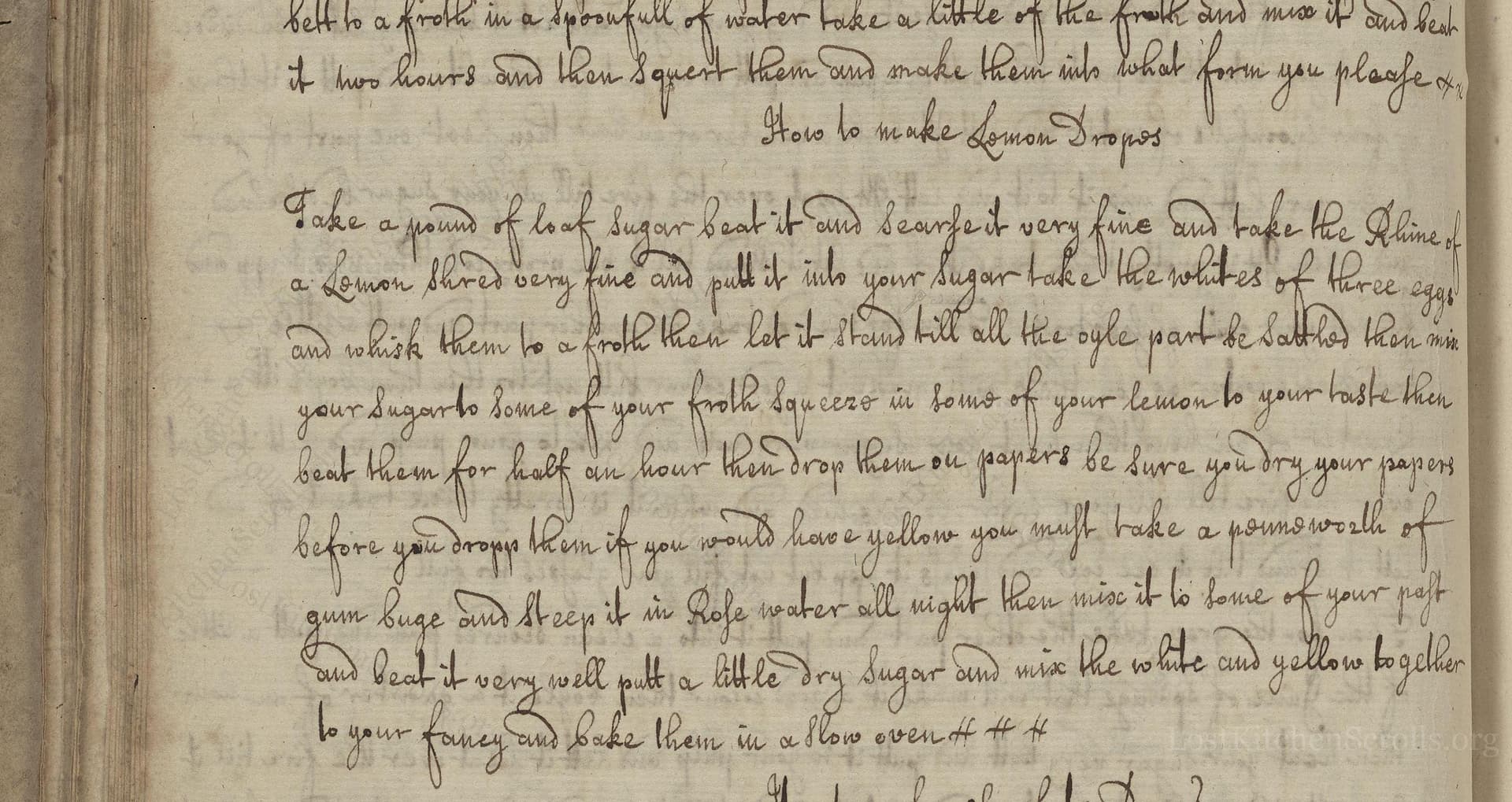How To Make Lemon Dropps
From the treasured pages of Mrs. Rachel Kirk Book 1707
Written by Rachel Kirk

How To Make Lemon Dropps
"Take a pound of loaf Sugar beat it and Searse it very fine and take the Rind of a Lemon Shred very fine and the whites of three eggs and whisk them to a froth then put it into your Sugar then let it stand till all the oyle part be Settled then with your froth Squeeze in some of your lemon to your taste then beat them for half an hour then drop them on papers be Sure you dry your papers before you dropp them if you please you may make a print with them."
Note on the Original Text
This recipe, typical of the period, is written in a single stream-of-consciousness paragraph with minimal punctuation and no standardized measurements. Spelling is phonetic (e.g., 'dropp' for 'drop', 'oyl' for 'oil', 'searse' for 'sieve'), reflecting early 18th-century English usage. Instructions assume a basic knowledge of kitchen processes and do not specify baking temperature or time, as cooking then relied on experience and observation. The unusually long beating time suggests an early form of meringue-like confection.

Title
Mrs. Rachel Kirk Book 1707 (1707)
You can also click the book image above to peruse the original tome
Writer
Rachel Kirk
Era
1707
Publisher
Unknown
Background
A remarkable collection of early 18th-century recipes, Rachel Kirk's work invites readers into the kitchens of the past where classic culinary traditions and timeless flavors come alive. Expect a charming medley of savory feasts and sweet treats reflective of the era's sophisticated palate.
Kindly made available by
Folger Shakespeare Library
This recipe comes from the handwritten collection of Rachel Kirk in 1707, offering a fascinating glimpse into early 18th-century English confectionery. Lemon drops were a simple yet elegant sweet, made in households with access to imported citrus and refined sugar, both considered luxury items at the time. Recipes like this circulated among women of the middling and upper classes, reflecting their social networks and culinary creativity.

In Rachel Kirk's day, the sugar would be broken from a hard loaf using a sugar nipper, then pounded fine with a mortar and pestle and sifted through a fine sieve. Lemons would be hand-zested with a small knife. Eggs were separated and whisked with a bundled birch-twig whisk or a fork. The mixture would be beaten by hand for an extended time, likely in a deep ceramic or wooden bowl. Paper for drying would be sheets of writing or parchment paper, dried before use by placing near the fire or in the sun.
Prep Time
50 mins
Cook Time
0 mins
Servings
24
We've done our best to adapt this historical recipe for modern kitchens, but some details may still need refinement. We warmly welcome feedback from fellow cooks and culinary historians — your insights support the entire community!
Ingredients
- 1 lb (16 oz) white granulated sugar (substitute for loaf sugar)
- Zest of 1 lemon (finely shredded, only the yellow part)
- Juice of 1/2 lemon, to taste
- Whites of 3 large eggs
Instructions
- To make Lemon Drops as Rachel Kirk did in 1707, begin with 1 pound (16 ounces) of very finely sifted white sugar.
- Grate the zest of one lemon as finely as possible, taking care to avoid the bitter white pith.
- Whisk the whites of three large eggs to a light froth in a clean bowl.
- Allow this froth to stand briefly, then gently stir it into the prepared sugar, allowing the frothy mixture to settle so the aromatic lemon oil can infuse the sugar.
- Squeeze in a little fresh lemon juice to taste and then beat the mixture thoroughly for about 30 minutes — or until thick and glossy.
- Drop small spoonfuls of the mixture onto pre-warmed parchment-covered baking sheets (make sure the parchment is absolutely dry).
- If you wish, imprint them with a small decorative stamp.
- Let them dry at room temperature until set and slightly crisp.
Estimated Calories
45 per serving
Cooking Estimates
You will need about 20 minutes to prepare the ingredients and whip everything together, then about 30 minutes of beating the mixture until it's thick and glossy. The Lemon Drops do not require baking, but they should be left to dry at room temperature for several hours or overnight until set. Each Lemon Drop is about 45 calories, and the recipe makes about 24 pieces.
As noted above, we have made our best effort to translate and adapt this historical recipe for modern kitchens, taking into account ingredients nowadays, cooking techniques, measurements, and so on. However, historical recipes often contain assumptions that require interpretation.
We'd love for anyone to help improve these adaptations. Community contributions are highly welcome. If you have suggestions, corrections, or cooking tips based on your experience with this recipe, please share them below.
Join the Discussion
Rate This Recipe
Dietary Preference
Main Ingredients
Culinary Technique

Den Bockfisch In Einer Fleisch Suppen Zu Kochen
This recipe hails from a German manuscript cookbook compiled in 1696, a time whe...

Die Grieß Nudlen Zumachen
This recipe comes from a rather mysterious manuscript cookbook, penned anonymous...

Ein Boudain
This recipe comes from an anonymous German-language manuscript cookbook from 169...

Ein Gesaltzen Citroni
This recipe, dating from 1696, comes from an extensive anonymous German cookbook...
Browse our complete collection of time-honored recipes



